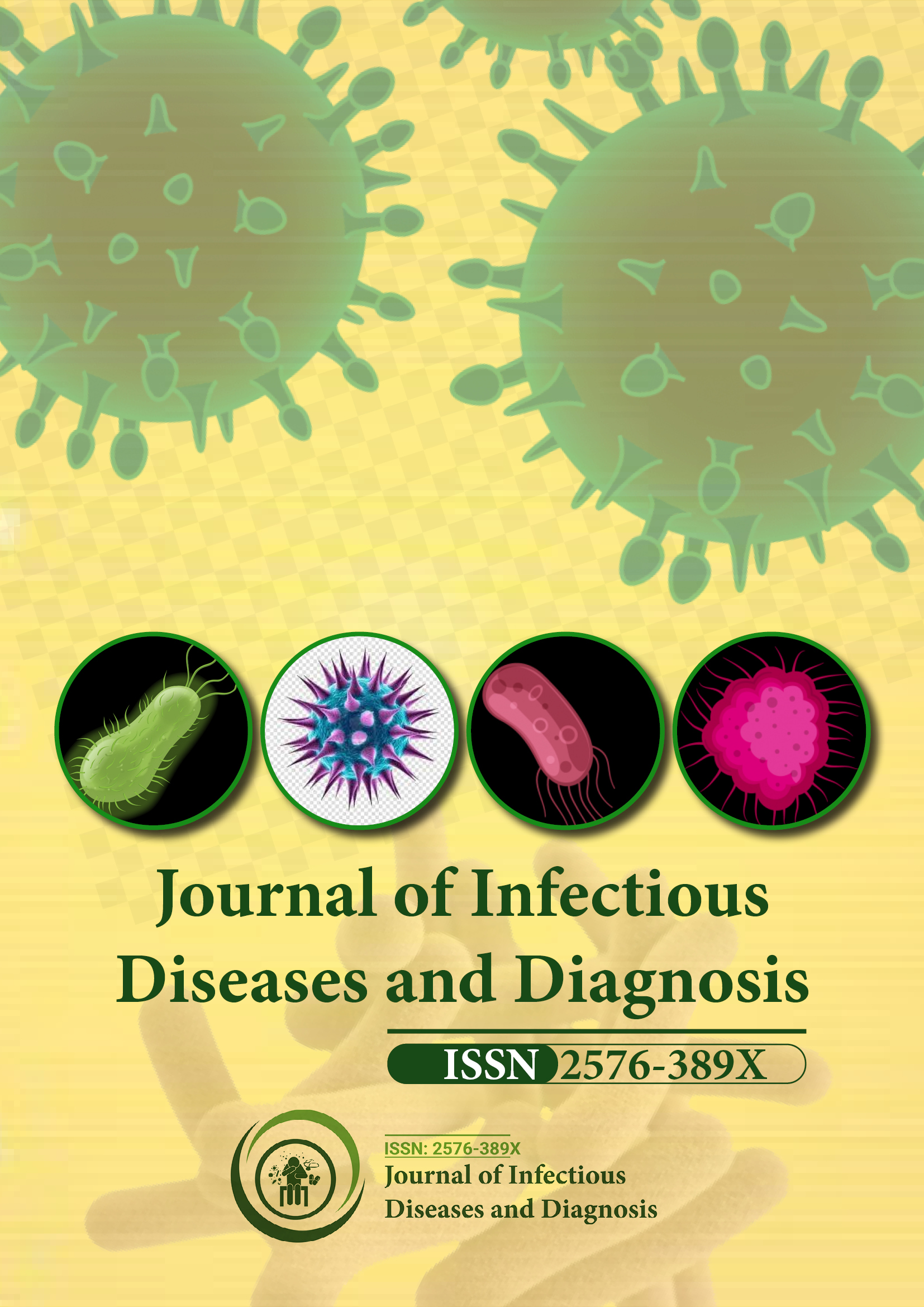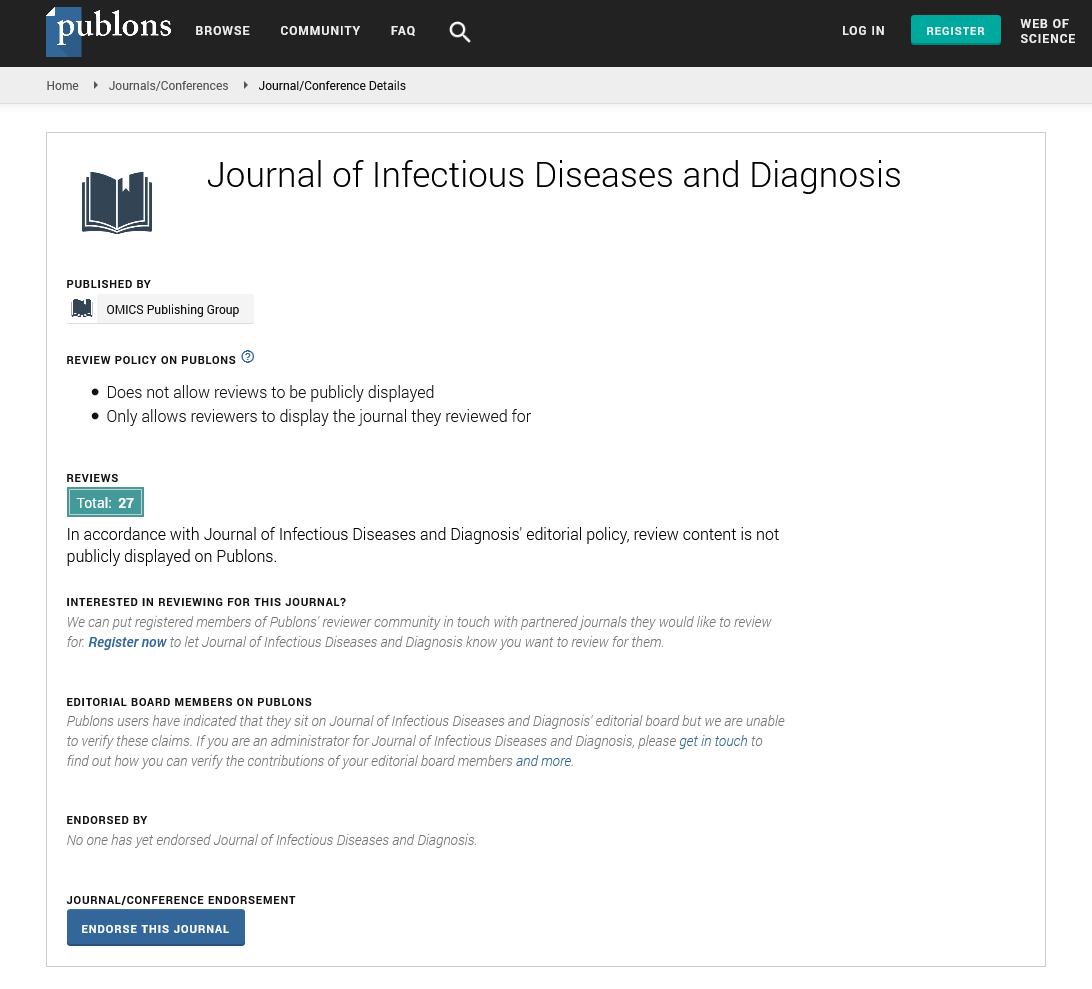Indexed In
- RefSeek
- Hamdard University
- EBSCO A-Z
- Publons
- Euro Pub
- Google Scholar
Useful Links
Share This Page
Journal Flyer

Open Access Journals
- Agri and Aquaculture
- Biochemistry
- Bioinformatics & Systems Biology
- Business & Management
- Chemistry
- Clinical Sciences
- Engineering
- Food & Nutrition
- General Science
- Genetics & Molecular Biology
- Immunology & Microbiology
- Medical Sciences
- Neuroscience & Psychology
- Nursing & Health Care
- Pharmaceutical Sciences
Opinion Article - (2024) Volume 9, Issue 6
Epidemiology and Prevention of Ebola Virus Disease: Challenges and Strategies
Niangua Tamami*Received: 28-Oct-2024, Manuscript No. JIDD-24-27715; Editor assigned: 30-Oct-2024, Pre QC No. JIDD-24-27715 (PQ); Reviewed: 14-Nov-2024, QC No. JIDD-24-27715; Revised: 21-Nov-2024, Manuscript No. JIDD-24-27715 (R); Published: 29-Nov-2024, DOI: 10.35248/2576-389X.24.09.307
Description
Ebola Virus Disease (EVD) is a severe, often fatal illness caused by the Ebola virus, which primarily affects humans and non- human primates. First identified in 1976 during outbreaks in Sudan and the Democratic Republic of Congo (DRC), EVD has since caused sporadic outbreaks across central and West Africa. The disease’s high mortality rate, rapid onset of symptoms and alarming transmission mode make it a significant public health concern.
Transmission and spread
EVD is transmitted to humans through direct contact with bodily fluids such as blood, vomit, feces and sweat from an infected person or animal. The virus can also be transmitted through contaminated objects, such as needles and from infected animals, particularly fruit bats and non-human primates. Humans typically acquire the virus after being exposed to an infected animal or person, but secondary transmission among humans occurs when there is close contact with the body fluids of an infected individual.
The primary reservoir of the Ebola virus is believed to be fruit bats, though other animals such as monkeys and apes can also serve as vectors. Outbreaks often begin in rural areas where people have close contact with wildlife and then spread to communities through human-to-human transmission, especially in healthcare settings where proper infection control measures are not in place.
Symptoms and progression
The symptoms of EVD can appear anywhere from 2 to 21 days after exposure to the virus, but typically emerge within 8 to 10 days. Early symptoms resemble those of many other viral infections and include fever, headache, muscle pain and fatigue. As the disease progresses, more severe symptoms develop, including vomiting, diarrhea, rash, impaired liver and kidney function and internal bleeding. In many cases, patients experience hemorrhagic manifestations such as bleeding from the gums, nose, or eyes and bruising.
The virus attacks the immune system, impairing the body’s ability to fight off infection. The severe bleeding, along with organ failure, leads to shock and death in many cases. The mortality rate varies depending on the strain of the virus, the healthcare infrastructure available and the timing of medical intervention. In the 2014-2016 outbreak, the case fatality rate was approximately 40%, though it reached higher rates in some regions due to late-stage presentation of symptoms and a lack of adequate medical resources.
Diagnosis and treatment
Diagnosing EVD in its early stages can be challenging due to the similarity of its symptoms to those of other diseases, such as malaria and typhoid fever. Laboratory tests, including Polymerase Chain Reaction (PCR) assays, are essential for confirming the presence of the Ebola virus. These tests are typically performed at specialized laboratories, which limits the speed of diagnosis in areas with limited access to healthcare infrastructure.
Currently, there is no specific antiviral treatment for EVD. However, supportive care such as fluid replacement, oxygen therapy and treatment of secondary infections can improve patient outcomes if administered early. In addition to supportive care, the use of experimental treatments and immune therapies has shown promise in reducing mortality. For instance, monoclonal antibodies such as Inmazeb and Ebanga, which received emergency use approval by the World Health Organization (WHO), have demonstrated efficacy in treating patients with EVD by targeting the virus directly.
Prevention and control measures
The spread of Ebola virus can be significantly reduced through a combination of public health measures and individual protective actions. The most effective methods of prevention include:
Early detection and quarantine: Rapid identification of individuals with symptoms of EVD and their immediate isolation can help reduce transmission. Infected patients should be cared for in specialized treatment units with strict infection control protocols. Quarantine measures, such as the restriction of movement in and out of affected areas, may also be used to prevent the virus from spreading to new regions.
Vaccination: In recent years, a vaccine known as rVSV-ZEBOV has been developed and shown to be highly effective in preventing EVD. The vaccine was first tested during the 2014-2016 West Africa outbreak and has since been deployed in subsequent outbreaks. It is typically administered to individuals at high risk, such as healthcare workers and people living in or near outbreak zones.
Community education: Public education campaigns are important for raising awareness about how EVD spreads and the steps people can take to protect themselves. Informing communities about the importance of hygiene, safe burial practices and the need for early medical care can help reduce the risk of infection.
Challenges in controlling Ebola
Despite advancements in treatment and prevention, several challenges remain in the fight against Ebola. One significant barrier is the mistrust of health authorities in some regions, where fear and misinformation can hinder efforts to control outbreaks. Additionally, the logistical difficulties of delivering vaccines, treatments and healthcare services to remote areas with poor infrastructure make it challenging to respond quickly during an outbreak.
Conclusion
Ebola Virus Disease continues to pose a serious threat to public health, particularly in regions with limited healthcare infrastructure. While advancements in diagnostics, treatments and vaccines have improved the response to outbreaks, ongoing efforts are needed to prevent the spread of the disease. Surveillance, education and the prompt identification of cases remain key to minimizing the impact of Ebola and protecting vulnerable populations. With continued investment in research and public health initiatives, the global community can work toward reducing the burden of EVD and preventing future outbreaks.
Citation: Tamami N (2024). Epidemiology and Prevention of Ebola Virus Disease: Challenges and Strategies. J Infect Dis Diagn. 9:307.
Copyright: © 2024 Tamami N. This is an open-access article distributed under the terms of the Creative Commons Attribution License, which permits unrestricted use, distribution and reproduction in any medium, provided the original author and source are credited.

